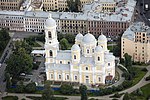Petrovsky Stadium

The Petrovsky Stadium (Russian: стадион «Петровский») is on a sports complex that consists of a number of buildings, the stadium is used mostly for football and also for athletics. The Grand Sport Arena of the Petrovsky Sport Complex was the home of FC Zenit and FC Tosno. The complex also contains another football stadium, Minor Sport Arena (MSA). MSA of Petrovsky in 2008 was used by several teams that compete in lower professional leagues: FC Dynamo Saint Petersburg, FC Zenit-2 Saint Petersburg, and FC Sever Murmansk. The whole complex is located on the Petrograd side in central St. Petersburg on Petrovsky Island, an island in the Malaya Neva River connected to the adjacent Krestovsky and Petrogradsky islands through bridges.
Excerpt from the Wikipedia article Petrovsky Stadium (License: CC BY-SA 3.0, Authors, Images).Petrovsky Stadium
Bolshoy Prospekt (Petrograd Side), Saint Petersburg Petrograd Side (Петровский округ)
Geographical coordinates (GPS) Address Website External links Nearby Places Show on map
Geographical coordinates (GPS)
| Latitude | Longitude |
|---|---|
| N 59.951944444444 ° | E 30.286388888889 ° |
Address
Большая спортивная арена спорткомплекса «Петровский»
Bolshoy Prospekt (Petrograd Side)
197198 Saint Petersburg, Petrograd Side (Петровский округ)
Saint Petersburg, Russia
Open on Google Maps








